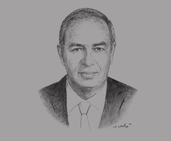Yehia Zaki, Director of Operations, Egypt, Dar Al-Handasah: Interview

Interview: Yehia Zaki
What is the timeline for the development of the economic zone?
YEHIA ZAKI: The objective of the Suez Canal Area Development Project goes beyond just transforming the 460 sq km of land that has been set aside surrounding the canal; it is a strategy for the development of the entire region. We have identified three distinct geographical areas of focus, consisting of six ports and three industrial zones in East Port Said, Qantarah and Sokhna.
There are two specific milestones related to the project, 2030 and 2050, with the first having been split into three development plans of five years each. The first phase foresees an expansion of two ports, and the planning and marketing of the three industrial zones. It will also include necessary infrastructure work such as setting up transport linkages and means of communication. We hope to create 1m new jobs by 2030 and an additional 2.4m by the end of phase two. We are also forecasting a doubling in the population of the region over the next 15 years. The idea is to get people to go there to work and to live and, in essence, to create a whole new community.
In what sectors do you foresee the most opportunities for investment within the zone?
ZAKI: A number of target industries have been identified for each industrial zone based on their unique characteristics and access to transport facilities. The industrial area surrounding East Port Said will consist primarily of light and medium-sized industries that complement its role as a centre for trans-shipment and the container business – for instance, packaging and labelling, domestic consumables and electronics, car components, and engineering and commerce-related industries. There will also be a logistics area that will link this new industrial nucleus to the port. Qantarah does not have port access, so there is talk of developing a dry port there. Given that the surrounding area is mostly agricultural land, this zone will focus on agribusiness industries like textiles and food processing. Affordable residential developments as well as areas for IT development, research and development facilities and training centres will also be included. The last one, near Sokhna, will also be the largest and will focus on heavy industry, such as steel production and pharmaceuticals as well as housing, entertainment and retail. It will also present a lot of opportunities downstream for suppliers of these industries, especially small and medium-sized enterprises and logistics-related services.
How will special legislation encourage development and growth in the economic zones?
ZAKI: This area is covered by the law governing special economic zones, Law No. 83 from 2002, which was amended in June 2015 and applied to the area in August. As part of the law, an authority has been set up to govern the zone and to act as a one-stop shop for investors, meaning that it will be responsible for obtaining all licences and approvals. In addition, the authority will also be able to act autonomously when dealing with other government agencies.
This should cut down a lot of the time it takes to get the necessary approvals and licensing for establishing operations, which should promote increased investment. It will also have some mechanism to set up free zones so that manufacturers can more easily export and re-export products. The idea is to ease some of the bureaucratic red tape and make it easier to do business in the country. Already, more than 60 companies have approached the authority to express their interest in investing in Egypt’s special economic zones.
You have reached the limit of premium articles you can view for free.
Choose from the options below to purchase print or digital editions of our Reports. You can also purchase a website subscription giving you unlimited access to all of our Reports online for 12 months.
If you have already purchased this Report or have a website subscription, please login to continue.

